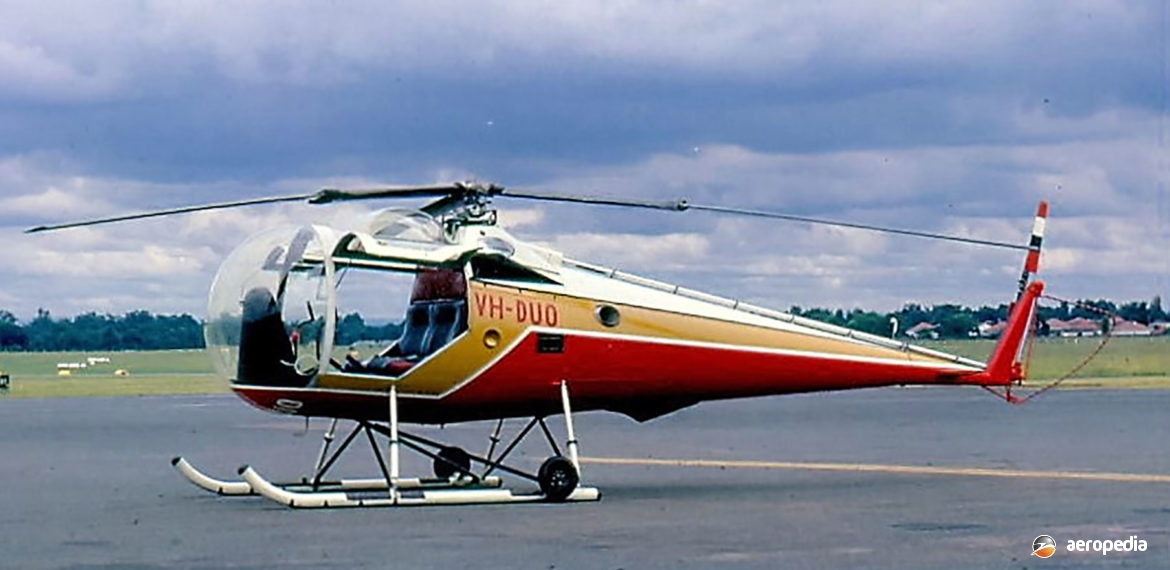Photograph:
Brantly B-2 VH-DUO (c/n 61) at Bankstown, NSW in October 1974 (David C Eyre)
Country of origin:
United States of America
Description:
Two-seat light helicopter
Power Plant:
One 134 kw (180 hp) Lycoming VO-360-A1A four-cylinder horizontally-opposed air-cooled engine
Specifications:
- Rotor diameter: 7.24 m (23 ft 8 1/8 in)
- Length: 6.62 m (21 ft 9 in)
- Height: 2.13 m (6 ft 11¾ in)
- Max speed: 161 km/h (100 mph)
- Cruising speed at 55% power: 153 km/h (95 mph)
- Rate of climb at sea level: 480 m/min (1,580 ft/min)
- Service ceiling: 3,475 m (11,400 ft)
- Hovering ceiling in ground effect: 2,440 m (8,000 ft)
- Max range with reserves: 480 km (300 miles)
- Empty weight: 445 kg (980 lb)
- Loaded weight: 726 kg (1,600 lb)
History:
The Brantly Helicopter Corporation was formed at Philadelphia, Pennsylvania, USA by Mr N O Brantly during World War II to develop his design of a co-axial rotor helicopter known as the B-1. The prototype was flown for the first time during 1946, but this model did not enter production.
Development proceeded to the B-2 with a single rotor. The B-2 prototype was flown for the first time on 21 February 1953, followed by the second prototype on 14 August 1956. A two-seat general-purpose helicopter, the B-2 was evaluated by the British Army, but an order was not forthcoming. The first production B-2 was delivered in April 1959, and about 200 had been completed when production changed to the modified B-2A.
The B-2A was distinguished from the B-2 in having a re-designed cabin, engine accessory refinements, and a more comprehensive range of equipment. The most noticeable difference to the observer was the re-designed cockpit canopy to improve visibility. A subsequent model was the B-2B, which had a fuel-injected engine, thus permitting the gross weight to be increased to 758 kg (1,670 lb).
Further development led to the Model 306, which was produced in parallel with the B-2B. This machine utilised a similar rotor system and the entire tail section of its predecessor, and was offered with a wheel undercarriage. Powered by a 228 kw (305 hp) Lycoming IVO-540-A1A six-cylinder engine, it had a double flapping-hinge rotor system which offered resonance-free characteristics.
Over the years the Company has had a number of owners but not a great number of machines have been produced. In January 1975 Hynes Helicopter Company was formed to replace Brantly Operations Inc and put the two-seat H-2 (formerly the B-2B) back into production. It also introduced the H2-1 as an instrument trainer, a remotely piloted variant, and the larger H-5 model. In later years the aircraft was produced by Qindag Hall Helicopters in China, which has produced a UAV model known as the V750 UAV.
The first Brantly B-2 registered in Australia VH-DUO (c/n 61) was first registered in March 1961 and was flown in the Sydney, NSW area until it was withdrawn from service in April 1976. It is still believed to be extant.
Other examples have been imported, including a B-2B VH-FBE (c/n 2008) which was removed from the register in October 2015, having crashed and been destroyed near Gulgong, NSW on 22 January 2006.
One was registered in New Zealand as ZK-HFA (c/n 180) at Lyttleton. This machine was first registered in Anchorage, Alaska as N213U until imported to New Zealand as ZK-HFA and registered to L T Larrivee of Queenstown in March 1973. In 1974 it was with R A Presland of Wanaka, and by May 1979 had moved to J R Stark of Lyttleton. The registration was revoked in August 1997 and it was placed in a container and stored. In 2019 it was obtained on long-term loan by the NZ Helicopter Heritage Museum in Christchurch for restoration and display.
In June 2005 a further example was imported, ZK-INK (c/n 417), a model B-2B, for Gumboot Airways Ltd of Auckland.

